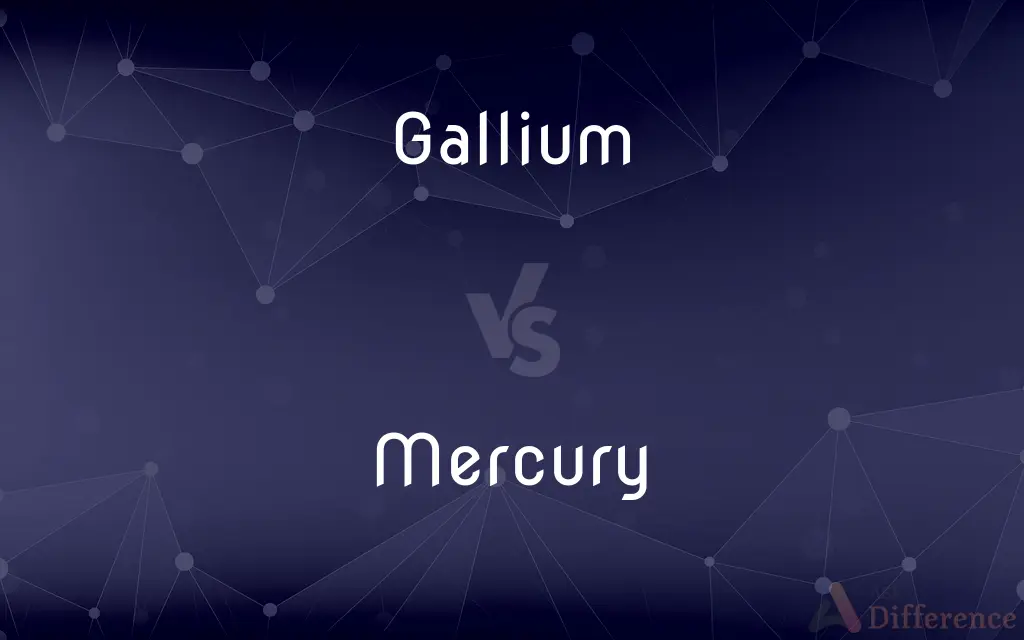Gallium vs. Mercury — What's the Difference?
By Tayyaba Rehman — Updated on December 24, 2023
Gallium is a soft, silvery metal, while Mercury is a liquid metal at room temperature.

Difference Between Gallium and Mercury
Table of Contents
ADVERTISEMENT
Key Differences
Gallium is a chemical element with the symbol Ga and atomic number 31, known for its low melting point. Mercury, with the symbol Hg and atomic number 80, is unique for being the only metal liquid at standard conditions for temperature and pressure.
Gallium does not occur as a free element in nature, but as compounds in trace amounts in zinc ores and in bauxite. Conversely, Mercury is found primarily in the mineral cinnabar and is used in various applications such as thermometers and fluorescent lighting.
Gallium is used in semiconductors and LEDs due to its electronic properties. Mercury, on the other hand, has historically been used in barometers and manometers because of its high density and liquid form.
Gallium’s low toxicity makes it safer for use in electronics and medical applications. Mercury is highly toxic, leading to its decreased usage and careful handling in modern times.
In terms of physical properties, Gallium melts near room temperature, making it melt in the hand. Mercury remains in a liquid state, which has fascinated scientists and the public for centuries.
ADVERTISEMENT
Comparison Chart
State at Room Temperature
Solid, but melts near room temperature
Liquid
Uses
Semiconductors, LEDs
Thermometers, fluorescent lighting
Occurrence
In zinc ores and bauxite
Mainly in cinnabar
Toxicity
Low
High
Unique Property
Melts in hand
Only metal liquid at room temperature
Compare with Definitions
Gallium
Gallium is used in semiconductors.
The smartphone's microchip likely contains gallium.
Mercury
Mercury is a liquid metal at room temperature.
Mercury’s unique liquid state makes it useful in thermometers.
Gallium
Gallium is a soft, silvery metal.
Gallium’s low melting point allows it to melt in your hand.
Mercury
Mercury is used in barometers.
Old barometers used mercury to measure atmospheric pressure.
Gallium
Gallium has a low toxicity level.
Gallium is preferred in medical applications due to its safety.
Mercury
Mercury vapor is used in fluorescent lighting.
The bright glow of a fluorescent bulb is partly due to mercury vapor.
Gallium
Gallium compounds are used in LEDs.
The bright light of modern LEDs is often due to gallium.
Mercury
Mercury is found in the mineral cinnabar.
Mercury is extracted from cinnabar for various industrial uses.
Gallium
Gallium is not found as a free element in nature.
Scientists extract gallium from bauxite for industrial use.
Mercury
Mercury is toxic.
Due to its toxicity, mercury is being phased out in many applications.
Gallium
Gallium is a chemical element with the symbol Ga and atomic number 31. Discovered by French chemist Paul-Émile Lecoq de Boisbaudran in 1875, Gallium is in group 13 of the periodic table and is similar to the other metals of the group (aluminium, indium, and thallium).
Mercury
Roman Mythology A god that served as messenger to the other gods and was himself the god of commerce, travel, and thievery.
Gallium
A rare metallic element that is liquid near room temperature, expands on solidifying, and is found as a trace element in coal, bauxite, and other minerals. It is used in semiconductor technology, as a component of various low-melting alloys, and in producing blue light-emitting diodes. Atomic number 31; atomic weight 69.72; melting point 29.78°C; boiling point 2,403°C; specific gravity 5.907; valence 2, 3. See Periodic Table.
Mercury
The smallest of the planets and the one nearest the sun, having a sidereal period of revolution about the sun of 87.97 days at a mean distance of 57.91 million kilometers (35.98 million miles) and a mean radius of approximately 2,440 kilometers (1,516 miles).
Gallium
A chemical element (symbol Ga) with an atomic number of 31; a soft bluish metal.
Mercury
Symbol HgA silvery-white poisonous metallic element, liquid at room temperature and used in thermometers, barometers, vapor lamps, and batteries and in the preparation of chemical pesticides. Atomic number 80; atomic weight 200.59; melting point -38.83°C; boiling point 356.62°C; specific gravity 13.546 (at 20°C); valence 1, 2.Also called quicksilver. See Periodic Table.
Gallium
A rare metallic element, found combined in certain zinc ores. It is white, hard, and malleable, resembling aluminium, and remarkable for its low melting point (86° F., 30° C.). Symbol, Ga; at. wt., 69.9. Gallium is chiefly trivalent, resembling aluminium and indium. It was predicted with most of its properties, under the name eka-aluminium, by the Russian chemist Mendelyeev on the basis of the periodic law. This prediction was verified in its discovery (in 1875) by the French chemist Lecoq de Boisbaudran by its characteristic spectrum (two violet lines), in an examination of a zinc blende from the Pyrenees.
Mercury
Temperature:The mercury had fallen rapidly by morning.
Gallium
A rare silvery (usually trivalent) metallic element; brittle at low temperatures but liquid above room temperature; occurs in trace amounts in bauxite and zinc ores
Mercury
Any of several weedy plants of the genera Mercurialis and Acalypha.
Mercury
A metal.
Mercury
A silvery-colored, toxic, metallic chemical element, liquid at room temperature, with atomic number 80 and symbol Hg.
Mercury
One of the elemental principles formerly thought to be present in all metals.
Mercury
(with definite article) Ambient pressure or temperature (from the use of mercury in barometers and thermometers).
The mercury there has averaged 37.6°C, 2.3°C above the February norm.
Mercury
(obsolete) Liveliness, volatility.
Mercury
Any of several types of plant.
Mercury
An annual plant, annual mercury (Mercurialis annua), formerly grown for its medicinal properties; French mercury, herb mercury.
Mercury
Any plant of any species of the genus and the genus Mercurialis.
Mercury
A similar edible plant (Blitum bonus-henricus), otherwise known as English mercury or novern=1.
Mercury
The poison oak or poison ivy.
Mercury
A Latin god of commerce and gain; - treated by the poets as identical with the Greek Hermes, messenger of the gods, conductor of souls to the lower world, and god of eloquence.
Mercury
A metallic element mostly obtained by reduction from cinnabar, one of its ores. It is a heavy, opaque, glistening liquid (commonly called quicksilver), and is used in barometers, thermometers, etc. Specific gravity 13.6. Symbol Hg (Hydrargyrum). Atomic weight 199.8. Mercury has a molecule which consists of only one atom. It was named by the alchemists after the god Mercury, and designated by his symbol,
Mercury
One of the planets of the solar system, being the one nearest the sun, from which its mean distance is about 36,000,000 miles. Its period is 88 days, and its diameter 3,000 miles.
Mercury
A carrier of tidings; a newsboy; a messenger; hence, also, a newspaper.
Mercury
Sprightly or mercurial quality; spirit; mutability; fickleness.
He was so full of mercury that he could not fix long in any friendship, or to any design.
Mercury
A plant (Mercurialis annua), of the Spurge family, the leaves of which are sometimes used for spinach, in Europe.
Mercury
To wash with a preparation of mercury.
Mercury
A heavy silvery toxic univalent and bivalent metallic element; the only metal that is liquid at ordinary temperatures
Mercury
(Roman mythology) messenger of Jupiter and god of commerce; counterpart of Greek Hermes
Mercury
The smallest planet and the nearest to the sun
Mercury
Temperature measured by a mercury thermometer;
The mercury was falling rapidly
Common Curiosities
Can Gallium melt in your hand?
Yes, Gallium can melt in your hand due to its low melting point.
What is Mercury’s state at room temperature?
Mercury is a liquid at room temperature.
What is Gallium primarily used for?
Gallium is mainly used in semiconductors and LEDs.
Is Mercury toxic?
Yes, Mercury is highly toxic and requires careful handling.
Are Gallium and Mercury found in the same state in nature?
No, Gallium is found in solid form, while Mercury is found in liquid form.
Can Mercury be used in thermometers?
Yes, but its use is decreasing due to toxicity concerns.
What makes Gallium unique among metals?
Its ability to melt near room temperature makes it unique.
Is Gallium toxic?
Gallium has low toxicity, making it safe for various applications.
Why is Mercury used in fluorescent lights?
Mercury vapor helps produce light in fluorescent bulbs.
What are the environmental concerns with Mercury?
Mercury’s toxicity poses significant environmental and health risks.
How is Mercury contained or stored?
Mercury is stored in tightly sealed containers to prevent vapor release.
Where is Mercury found?
Mercury is primarily found in the mineral cinnabar.
How is Gallium extracted?
Gallium is extracted from zinc ores and bauxite.
What are some common applications of Gallium?
Gallium is commonly used in electronics, such as in smartphones and LED lights.
Are there any safe alternatives to Mercury in its applications?
Yes, safer alternatives like digital sensors are replacing Mercury in many applications.
Share Your Discovery

Previous Comparison
Narrative vs. Plot
Next Comparison
Brigantine vs. BrigAuthor Spotlight
Written by
Tayyaba RehmanTayyaba Rehman is a distinguished writer, currently serving as a primary contributor to askdifference.com. As a researcher in semantics and etymology, Tayyaba's passion for the complexity of languages and their distinctions has found a perfect home on the platform. Tayyaba delves into the intricacies of language, distinguishing between commonly confused words and phrases, thereby providing clarity for readers worldwide.















































